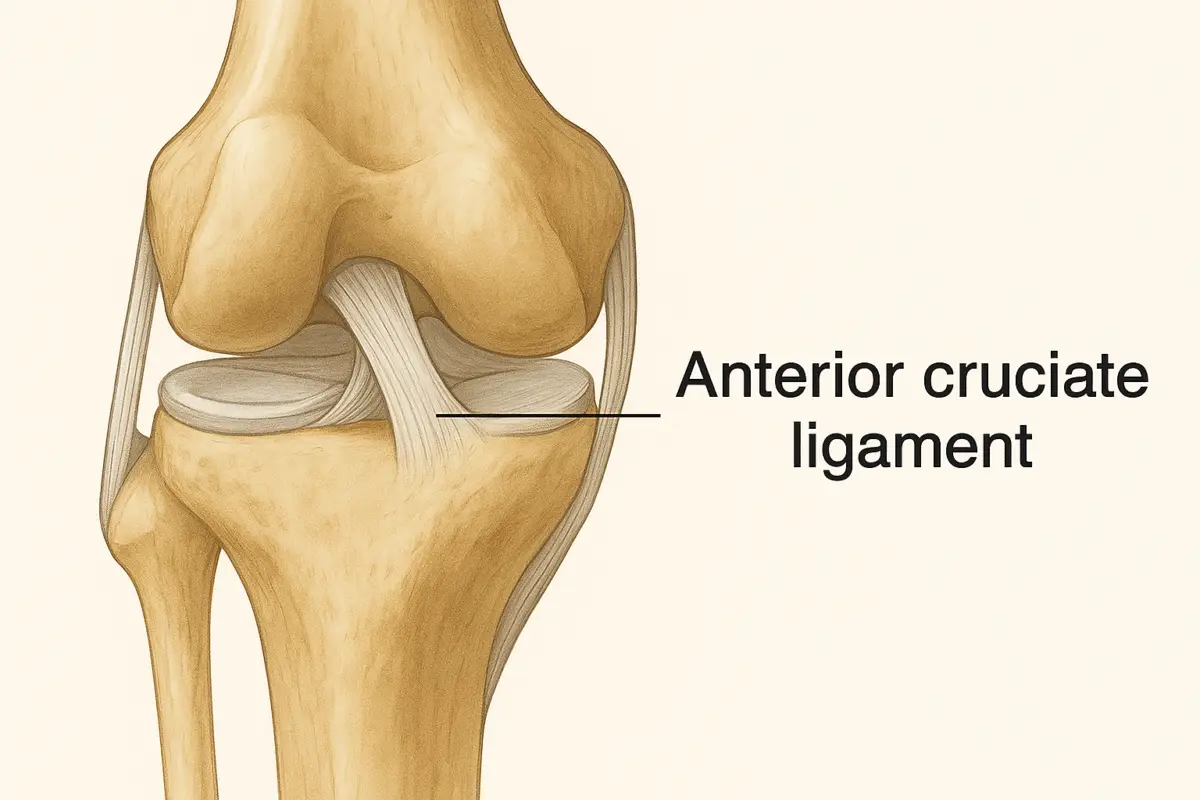Introduction
An Anterior Cruciate Ligament (ACL) injury is one of the most common and serious knee injuries, particularly among athletes and physically active individuals. The ACL is a strong band of tissue that connects the thigh bone (femur) to the shin bone (tibia) and plays a critical role in stabilizing the knee during movement. When injured, it can significantly impact mobility, athletic performance, and overall quality of life. Understanding its causes, symptoms, and rehabilitation process is essential for effective recovery and prevention.
Causes of ACL Injury
ACL injuries usually occur when the ligament is overstretched or torn due to excessive force or sudden movement. Common causes include:
- Sudden Change in Direction
Quick Change in Direction or cutting movements, common in sports like football, basketball, and hockey, can strain the ACL. - Improper Landing from a Jump
Improper landing after a jump in sports such as volleyball or basketball can put extreme stress on the ligament. - Direct Impact on the Knee
Collisions or tackles, especially from the side, can lead to ACL tears. - Overextension of the Knee Joint
Hyperextending the knee beyond its normal range of motion can injure the ligament. - Weak Muscles and Poor Biomechanics
Insufficient strength in the hamstrings, quadriceps, and hip muscles increases strain on the ACL.
Signs and Symptoms
An ACL injury typically presents with sudden and noticeable symptoms, such as:
- Popping Sound at the Time of Injury
Many individuals report hearing or feeling a “pop” in the knee when the injury occurs. - Severe Pain and Inability to Continue Activity
The pain is often immediate and intense, making it difficult to walk or bear weight. - Rapid Swelling
The knee may swell within hours due to internal bleeding. - Instability and Giving Way
The knee may feel loose or unstable, especially during turning or pivoting movements. - Reduced Range of Motion
Bending or straightening the knee may become difficult.
Diagnosis
The following Tests are used to diagnose an ACL injury:
1. Lachman Test (Most Sensitive Clinical Test)
Purpose: Detects anterior translation (forward movement) of the tibia, which indicates ACL laxity or tear.
How It’s Performed:
- The patient lies on their back with the knee flexed at about 20–30 degrees.
- The examiner stabilizes the femur with one hand and grips the upper tibia with the other.
- The tibia is gently pulled forward.
- Positive Sign: If the tibia moves forward more than the uninjured knee or there is a soft endpoint, it suggests ACL injury.
2. Anterior Drawer Test
Purpose: Checks forward movement of the tibia relative to the femur.
How It’s Performed:
- The patient lies on their back with the hip flexed to 45° and the knee flexed to 90 degrees.
- The examiner sits on the patient’s foot for stability, grasps the upper tibia with both hands, and pulls it forward.
- Positive Sign: Excessive forward movement compared to the unaffected knee.
3. Pivot Shift Test
Purpose: Detects rotational instability of the knee caused by ACL deficiency.
How It’s Performed:
- The patient lies on their back with the knee extended.
- The examiner lifts the leg, internally rotates the tibia, and applies a valgus (inward) stress while flexing the knee.
- Positive Sign: A sudden “shift” or “clunk” at around 30–40° of knee flexion, indicating the tibia’s abnormal movement.
4. Lever Sign Test (Lelli’s Test)
Purpose: A Simple, quick screening tool for ACL rupture.
How It’s Performed:
- The patient lies on their back with the leg extended.
- The examiner places a fist under the upper calf (just below the knee) and presses down on the distal thigh.
- Positive Sign: If the heel does not lift off the table when pressing down, it indicates a torn ACL.
Rehabilitation Protocol for ACL Injury
1. Early Stage (Weeks 1–3)
Goals:
- Control pain and swelling
- Protect the injured ligament
- Begin gentle mobility exercises
Rehab Strategies:
- Rest, Ice, Compression, Elevation (RICE)
- Quadriceps setting and straight leg raises
- Gentle heel slides to restore knee bending
2. Mid-Stage (Weeks 4–8)
Goals:
- Improve strength and flexibility
- Enhance balance and stability
Rehab Strategies:
- Closed-chain exercises like mini squats and step-ups
- Resistance band exercises for the quadriceps and hamstrings
- Balance training on stable and unstable surfaces
3. Advanced Stage (Weeks 9–16)
Goals:
- Regain functional strength
- Prepare for sports-specific movements
Rehab Strategies:
- Plyometric drills (box jumps, hopping)
- Agility ladder training
- Single-leg exercises for strength and stability
4. Return-to-Sport Phase (After 4–6 Months)
Goals:
- Achieve full strength and confidence in the knee
- Minimize the risk of re-injury
Rehab Strategies:
- High-intensity agility and cutting drills
- Sport-specific training under supervision
- Functional testing before clearance
Key Exercises for Anterior Cruciate Ligament Injury
Ankle Pump
Heel slide
Quadriceps isometric exercise
Straight Leg Raise
Heel Raises
Mid-Stage ACL Strengthening Exercises
Bridging Exercise
hamstring curls
Squatting Exercises
Steps-Up
lateral steps-up
Splits Squats
Prevention Tips
While not all ACL injuries are preventable, risk can be reduced by:
- Maintaining strong and flexible leg muscles
- Practicing proper jumping and landing techniques
- Including balance and agility training in workouts
- Wearing appropriate footwear for your sport
Conclusion
An ACL injury can be life-changing, but with prompt diagnosis, effective rehabilitation, and proper preventive strategies, full recovery is achievable. Whether you are an athlete aiming to return to competition or an active individual wanting to regain mobility, following a structured rehabilitation protocol under professional guidance is the key to success.






Outstanding